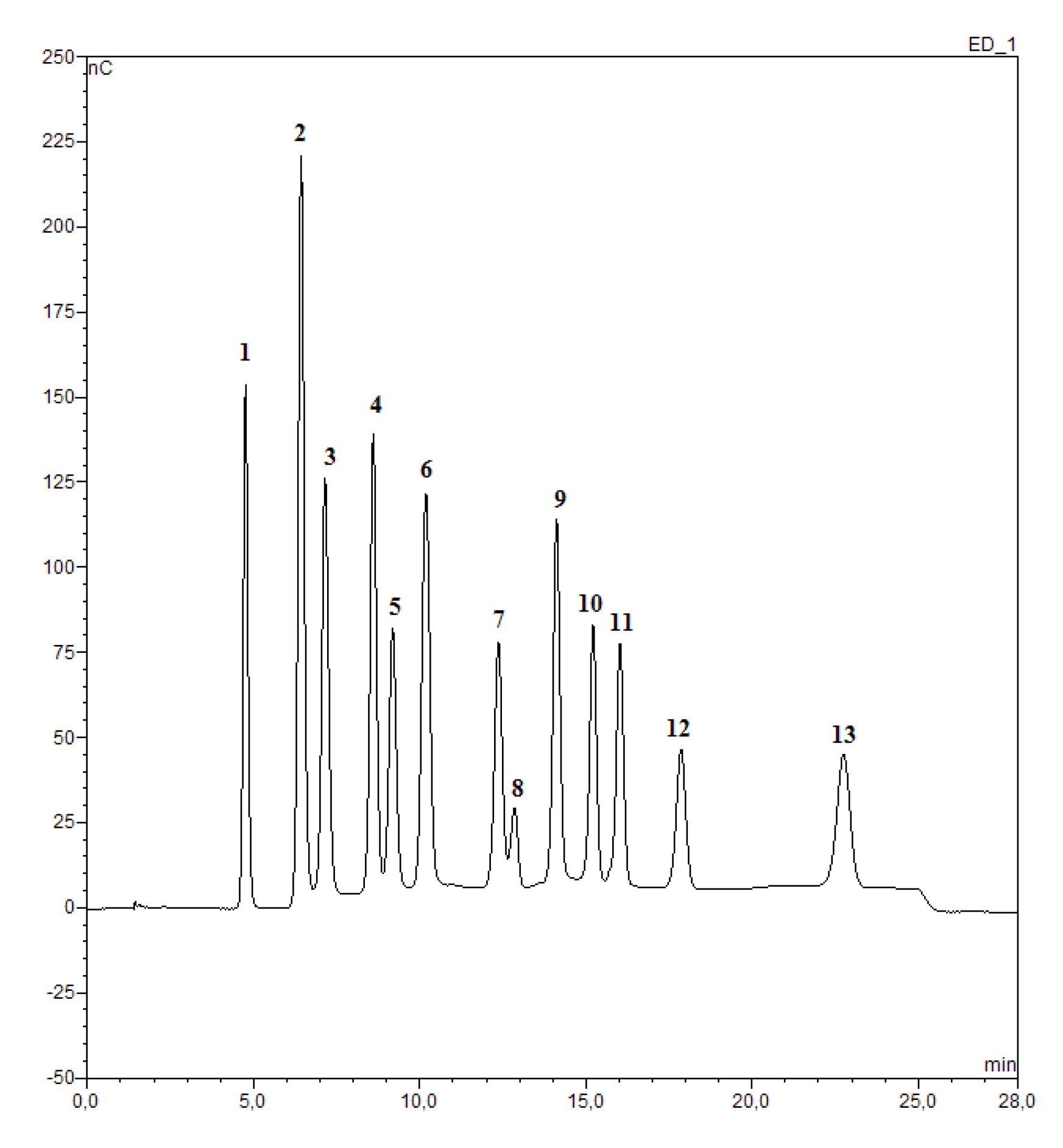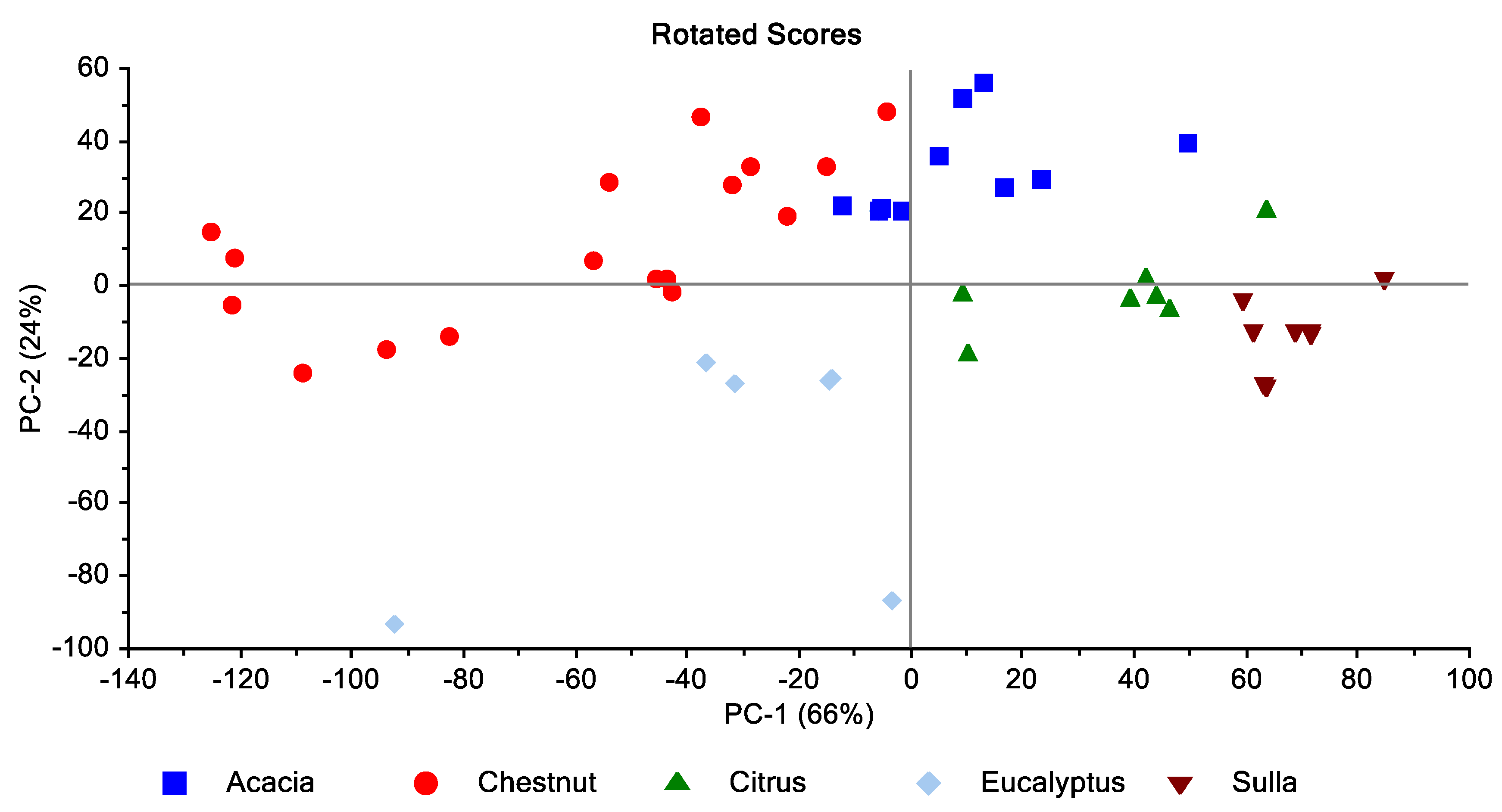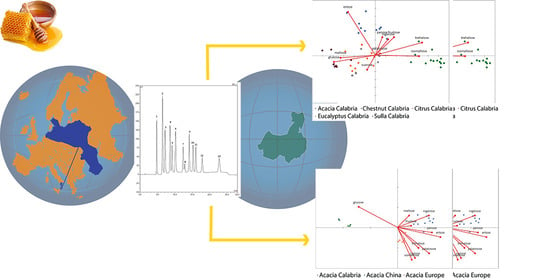High-Performance Anion Exchange Chromatography with Pulsed Amperometric Detection (HPAEC–PAD) and Chemometrics for Geographical and Floral Authentication of Honeys from Southern Italy (Calabria region)
Abstract
:1. Introduction
2. Materials and Methods
2.1. Chemicals and Reagents
2.2. Honey Samples
2.3. Sample Preparation
2.4. HPAEC–PAD Analysis
2.5. HPLC–RI Analysis
2.6. Calibration Curve
2.7. Statistical Analysis
3. Results and Discussion
3.1. HPAEC–PAD Analysis
3.2. Comparison HPAEC–PAD Method vs. Official Method HPLC–RI
3.3. Comparison Acacia Honeys from Calabria vs. Acacia Honeys from Europe and China
4. Conclusions
Supplementary Materials
Author Contributions
Funding
Acknowledgments
Conflicts of Interest
References
- Directive 2014/63/EU of the European Parliament and of the Council amending Council Directive 2001/110/EC relating to honey. Available online: https://eur-lex.europa.eu/legal-content/GA/TXT/?uri=CELEX:32014L0063 (accessed on 3 June 2014).
- Codex Alimentarius Commission. Revised Codex Standard for Honey, Codex Stan 12-1981; Rev. 1 (1987), Rev. 2 (2001); Food and Agriculture Organization (FAO): Rome, Italy, 2001. [Google Scholar]
- Belay, A.; Solomon, W.K.; Bultossa, G.; Adgaba, N.; Melaku, S. Botanical origin, colour, granulation, and sensory properties of the Harenna forest honey, Bale, Ethiopia. Food Chem. 2015, 167, 213–219. [Google Scholar] [CrossRef]
- Cabañero, A.I.; Recio, J.L.; Rupérez, M. Liquid chromatography coupled to isotope ratio mass spectrometry: A new perspective on honey adulteration detection. J. Agric. Food Chem. 2006, 54, 9719–9727. [Google Scholar] [CrossRef] [PubMed]
- Cordella, C.B.Y.; Militão, J.S.L.T.; Clément, M.C.; Cabrol-Bass, D. Honey characterization and adulteration detection by pattern recognition applied on HPAEC-PAD profiles. 1. Honey floral species characterization. J. Agric. Food Chem. 2003, 51, 3234–3242. [Google Scholar] [CrossRef]
- Iglesias, A.; Feás, X.; Rodrigues, S.; Seijas, J.A.; Vázquez-tato, M.P.; Dias, L.G.; Estevinho, L.M. Comprehensive Study of Honey with Protected Denomination of Origin and Contribution to the Enhancement of Legal Specifications. Molecules 2012, 17, 8561–8577. [Google Scholar] [CrossRef] [PubMed] [Green Version]
- Zhou, X.; Taylor, M.P.; Salouros, H.; Prasad, S. Authenticity and geographic origin of global honeys determined using carbon isotope ratios and trace elements. Sci. Rep. 2018, 8, 1–11. [Google Scholar] [CrossRef] [PubMed] [Green Version]
- Campone, L.; Piccinelli, A.L.; Pagano, I.; Carabetta, S.; Di Sanzo, R.; Russo, M.; Rastrelli, L. Determination of phenolic compounds in honey using dispersive liquid–liquid microextraction. J. Chromatogr. A 2014, 1334, 9–15. [Google Scholar] [CrossRef]
- Rizzo, S.; Russo, M.; Labra, M.; Campone, L.; Rastrelli, L. Determination of Chloramphenicol in Honey Using Salting-Out Assisted Liquid-Liquid Extraction Coupled with Liquid Chromatography-Tandem Mass Spectrometry and Validation According to 2002/657 European Commission Decision. Molecules 2020, 25, 3481. [Google Scholar] [CrossRef]
- Campone, L.; Celano, R.; Piccinelli, A.L.; Pagano, I.; Cicero, N.; Di Sanzo, R.; Carabetta, S.; Russo, M.; Rastrelli, L. Ultrasound assisted dispersive liquid-liquid microextraction for fast and accurate analysis of chloramphenicol in honey. Food Res. Int. 2019, 115, 572–579. [Google Scholar] [CrossRef]
- Da Costa Leite, J.M.; Trugo, L.C.; Costa, L.S.M.; Quinteiro, L.M.C.; Barth, O.M.; Dutra, V.M.L.; De Maria, C.A.B. Determination of oligosaccharides in Brazilian honeys of different botanical origin. Food Chem. 2000, 70, 93–98. [Google Scholar] [CrossRef]
- El Sohaimy, S.A.; Masry, S.H.D.; Shehata, M.G. Physicochemical characteristics of honey from different origins. Ann. Agric. Sci. 2015, 60, 279–287. [Google Scholar] [CrossRef] [Green Version]
- De La Fuente, E.; Ruiz-Matute, A.I.; Valencia-Barrera, R.M.; Sanz, J.; Martínez Castro, I. Carbohydrate composition of Spanish unifloral honeys. Food Chem. 2011, 129, 1483–1489. [Google Scholar] [CrossRef] [Green Version]
- Da Silva, P.M.; Gauche, C.; Gonzaga, L.V.; Costa, A.C.O.; Fett, R. Honey: Chemical composition, stability and authenticity. Food Chem. 2016, 196, 309–323. [Google Scholar] [CrossRef]
- Özcan, M.M.; Ölmez, Ç. Some qualitative properties of different monofloral honeys. Food Chem. 2014, 163, 212–218. [Google Scholar] [CrossRef] [PubMed]
- Tuberoso, C.I.G.; Jerković, I.; Sarais, G.; Congiu, F.; Marijanović, Z.; Kuś, P.M. Color evaluation of seventeen European unifloral honey types by means of spectrophotometrically determined CIE L* C*ab h°ab chromaticity coordinates. Food Chem. 2014, 145, 284–291. [Google Scholar] [CrossRef]
- Valdés-Silverio, L.A.; Iturralde, G.; García-Tenesaca, M.; Paredes-Moreta, J.; Narváez-Narváez, D.A.; Rojas-Carrillo, M.; Tejera, E.; Beltrán-Ayala, P.; Giampieri, F.; Alvarez-Suarez, J.M. Physicochemical parameters, chemical composition, antioxidant capacity, microbial contamination and antimicrobial activity of Eucalyptus honey from the Andean region of Ecuador. J. Apic. Res. 2018, 8839, 382–394. [Google Scholar]
- León-Ruiz, V.; Vera, S.; González-Porto, A.V.; Andrés, M.P.S. Vitamin C and sugar levels as simple markers for discriminating spanish honey sources. J. Food Sci. 2011, 76, 356–361. [Google Scholar] [CrossRef]
- Nozal, M.J.; Bernal, J.L.; Toribio, L.; Alamo, M.; Diego, J.C.; Tapia, J. The use of carbohydrate profiles and chemometrics in the characterization of natural honeys of identical geographical origin. J. Agric. Food Chem. 2005, 53, 3095–3100. [Google Scholar] [CrossRef]
- Bontempo, L.; Camin, F.; Ziller, L.; Perini, M.; Nicolini, G.; Larcher, R. Isotopic and elemental composition of selected types of Italian honey. Meas. J. Int. Meas. Confed. 2017, 98, 283–289. [Google Scholar] [CrossRef]
- Sant’Ana, L.D.O.; Sousa, J.P.L.M.; Salgueiro, F.B.; Lorenzon, M.C.A.; Castro, R.N. Characterization of monofloral honeys with multivariate analysis of their chemical profile and antioxidant activity. J. Food Sci. 2012, 77, 135–140. [Google Scholar] [CrossRef]
- Mannina, L.; Sobolev, A.P.; Di Lorenzo, A.; Vista, S.; Tenore, G.C.; Daglia, M. Chemical Composition of Different Botanical Origin Honeys Produced by Sicilian Black Honeybees (Apis mellifera ssp. sicula). J. Agric. Food Chem. 2015, 63, 5864–5874. [Google Scholar] [CrossRef]
- Girelli, R.; Villella, S.; Schiavone, R.; Fanizzi, F. Salento Honey (Apulia, South-East Italy): A Preliminary Characterization by 1H-NMR Metabolomic Fingerprinting. Sustainability 2020, 12, 5009. [Google Scholar] [CrossRef]
- Di Rosa, A.R.; Leone, F.; Cheli, F.; Chiofalo, V. Vincenzo Novel approach for the characterisation of Sicilian honeys based on the correlation of physicochemical parameters and artificial senses. Ital. J. Anim. Sci. 2018, 18, 389–397. [Google Scholar] [CrossRef]
- Giannoccaro, E.; Wang, Y.J.; Chen, P. Comparison of two HPLC systems and an enzymatic method for quantification of soybean sugars. Food Chem. 2008, 106, 324–330. [Google Scholar] [CrossRef]
- Ouchemoukh, S.; Schweitzer, P.; Bachir, M.; Djoudad-kadji, H.; Louaileche, H. HPLC sugar profiles of Algerian honeys. Food Chem. 2010, 121, 561–568. [Google Scholar] [CrossRef]
- Bentabol Manzanares, A.; García, Z.H.; Galdón, B.R.; Rodríguez, E.R.; Romero, C.D. Differentiation of blossom and honeydew honeys using multivariate analysis on the physicochemical parameters and sugar composition. Food Chem. 2011, 126, 664–672. [Google Scholar] [CrossRef]
- Bertoncelj, J.; Polak, T.; Kropf, U.; Korošec, M.; Golob, T.; Bertoncelj, J. LC-DAD-ESI/MS analysis of flavonoids and abscisic acid with chemometric approach for the classification of Slovenian honey. Food Chem. 2011, 127, 296–302. [Google Scholar] [CrossRef]
- Varmuza, K.; Filzmoser, P. Introduction to Multivariate Statistical Analysis in Chemometrics; Taylor & Francis Inc.: Abingdon, UK, 2009. [Google Scholar]
- Andric, F.; Trifkovic, J.; Lazarevic, K.B. Characterisation of Serbian unifloral honeys according to their physicochemical parameters. Food Chem. 2012, 132, 2060–2064. [Google Scholar]
- Dobre, I.; Georgescu, L.A.; Alexe, P.; Escuredo, O.; Seijo, M.C. Rheological behavior of different honey types from Romania. Food Res. Int. 2012, 49, 126–132. [Google Scholar] [CrossRef]
- Primorac , L.; Flanjak, I.; Kenjerić, D.; Bubalo, D.; Topolnjak, Z. Specific Rotation and Carbohydrate Profile of Croatian Unifloral Honeys. Czech J. Food Sci. 2011, 29, 515–519. [Google Scholar] [CrossRef] [Green Version]
- Escuredo, O.; Dobre, I.; González, M.; Seijo, M. Contribution of botanical origin and sugar composition of honeys on the crystallization phenomenon. Food Chem. 2014, 149, 84–90. [Google Scholar] [CrossRef]
- Escuredo, O.; Fernández-González, M.; Seijo, M.C. Nutritional value and antioxidant activity of honeys produced in a European Atlantic area. Food Chem. 2013, 138, 851–856. [Google Scholar] [CrossRef]
- Baloš, M.M.Z.; Popov, N.S.; Prodanov Radulović, J.Z.; Stojanov, I.M.; Jakšić, S.M. Sugar profile of different floral origin honeys from Serbia. J. Apic. Res. 2020, 59, 398–405. [Google Scholar] [CrossRef]
- Persano-Oddo, L.; Piro, R. Main European unifloral honeys: Descriptive sheets. Apidologie 2004, 35, S38–S81. [Google Scholar] [CrossRef]
- Cotte, J.F.; Casabianca, H.; Chardon, S.; Lheritier JGrenier-Loustalo, M.F. Chromatographic analysis of sugars applied to the characterisation of monofloral honey. Anal. Bioanal. Chem. 2004, 380, 698–705. [Google Scholar] [CrossRef]
- Schievano, E.; Sbrizza, M.; Zuccato, V.; Piana, L.; Tessari, M. NMR carbohydrate profile in tracing acacia honey authenticity. Food Chem. 2020, 309, 125788. [Google Scholar] [CrossRef]





| Sugars (%) | Honey Type (Number of Samples) | ||||
|---|---|---|---|---|---|
| Citrus | Eucalyptus | Sulla | Chestnut | Acacia | |
| (n = 12) | (n = 10) | (n = 12) | (n = 16) | (n = 10) | |
| Total MS | |||||
| Mean ± sd | 91 b,c ± 1,4 | 92.2 c±1.15 | 89.0 a,b ± 3.8 | 87.77 a ± 2.67 | 89.2 a,b ± 0.94 |
| Range | 88.3–92.6 | 90.1–93.3 | 77.7 ± 92.6 | 84.1–91.1 | 88.4–90.7 |
| Total DS | |||||
| Mean ± sd | 8.0 a ± 1.3 | 7.1 a ± 0.98 | 9.7 a,b ± 4.0 | 11.76 c ± 2.67 | 8.3 a ± 0.64 |
| Range | 6.9–10.8 | 6.1–8.5 | 6.2–21.6 | 8.8–15.7 | 7.8–9.7 |
| Total TS | |||||
| Mean ± sd | 1.1 b ± 0.5 | 0.8 a,b ± 0.26 | 1.2 b ± 0.4 | 0.46 a ± 0.41 | 2.4 c ± 0.55 |
| Range | 0.5–2 | 0.6–1.4 | 0.8–1.2 | 0.2–1.2 | 1.4–3.3 |
| Sugars (MG/G) | Honey Type (Number of Samples) | ||||
|---|---|---|---|---|---|
| Citrus | Eucalyptus | Sulla | Chestnut | Acacia | |
| (n = 12) | (n = 10) | (n = 12) | (n = 16) | (n = 10) | |
| Glucose | |||||
| Mean ± sd | 323.93 c ± 32.32 | 300.15 b.c ± 27.94 | 315.46 b.c ± 53.39 | 237.92 a ± 26.19 | 274.74 b ± 25.59 |
| Range | 270.38–366.89 | 277.22–332.60 | 190.30–354.42 | 188.93–278.58 | 237.04–305.84 |
| Fructose | |||||
| Mean ± sd | 424.61 a.b ± 13.93 | 421.14 a.b ± 57.86 | 398.28 a ± 22.31 | 437.29 b ± 21.91 | 445.46 b ± 27.77 |
| Range | 405.67–447.07 | 338.21–464.51 | 332.20–420.82 | 407.92–473.61 | 404.20–480.96 |
| Trehalose | |||||
| Mean ± sd | 2.43 b ± 0.56 | 1.58 a ± 0.77 | 1.52 a ± 0.82 | 4.17 c ± 0.61 | 2.89 b ± 0.42 |
| Range | 1.34–3.21 | 0.69–2.40 | 0.82–3.71 | 3.41–5.07 | 2.51–3.65 |
| Sucrose | |||||
| Mean ± sd | 2.41 a ± 3.05 | 7.34 a ± 10.30 | 6.82 a ± 9.65 | 3.29 a ± 2.67 | 1.41 a ± 0.94 |
| Range | 0.12–9.60 | 0.08–22.25 | 0.08–22.39 | 0.34–7.10 | 0.38–2.76 |
| Isomaltose | |||||
| Mean ± sd | 10.87 a ± 1.80 | 8.18 a ± 3.66 | 14.00 a ± 8.99 | 37.36 b ± 13.69 | 15.46 a ± 2.69 |
| Range | 8.25–14.68 | 3.72–13.09 | 6.61–38.46 | 22.14–57.63 | 9.96–17.40 |
| Koijbiose | |||||
| Mean ± sd | 4.36 b ± 1.28 | 2.52 a ± 1.28 | 4.36 b ± 1.28 | 4.00 b ± 0.94 | 6.18 c ± 1.33 |
| Range | 2..95–5.26 | nd–5.84 | 2..95–5.26 | nd–6.21 | 4.71–8.30 |
| Palatinose | |||||
| Mean ± sd | 15.40 a.b ± 4.24 | 13.56 a ± 5.07 | 19.37 b ± 9.68 | 21.68 a.b ± 4.17 | 19.01 a.b ± 3.02 |
| Range | 12.19–19.95 | 6.82–18.24 | 10.79–33.52 | 13.52–28.42 | 15.57–26.35 |
| Isomaltotriose | |||||
| Mean ± sd | 0.16 a ± 0.06 | 0.81 b ± 0.23 | 1.45 c ± 0.192 | 1.25 b.c ± 0.192 | 0.31 a ± 0.16 |
| Range | nd–0.23 | 0.4–1.06 | nd–1.96 | nd–1.36 | nd–0.43 |
| Nigerose | |||||
| Mean ± sd | 7.09 a ± 3.60 | 5.31 a ± 3.09 | 6.49 a ± 4.74 | 8.86 a ± 3.93 | 9.56 a ± 4.20 |
| Range | 2.53–14.51 | 2.98–10.20 | 2.53–16.35 | 5.46–20.01 | 3.27–14.93 |
| Maltose | |||||
| Mean ± sd | 27.27 c ± 7.08 | 18.64 a.b ± 6.30 | 23.56 b.c ± 7.37 | 11.58 a ± 3.94 | 18.94 b ± 6.90 |
| Range | 20.27–42.07 | 9.96–32.66 | 10.51–33.02 | 5.76–20.68 | 12.59–31.53 |
| Erlose | |||||
| Mean ± sd | 7.64 b ± 3.20 | 5.25 a.b ± 2.07 | 8.36 b ± 4.24 | 1.71 a ± 2.35 | 17.68 c ± 4.39 |
| Range | 3.70–13.90 | 3.51–10.21 | Nd–16.83 | nd–8.34 | 10.56–24.72 |
| Panose | |||||
| Mean ± sd | 1.15 a.b ± 0.94 | 0.75 a ± 0.61 | 1.65 a.b ± 1.35 | 1.72 a.b ± 0.74 | 2.06 b ± 0.87 |
| Range | 0.17–2.96 | Nd–1.48 | 0.37–5.09 | 0.98– 3.22 | 1.42–4.23 |
| Fructose (mg/g) | Glucose (mg/g) | |||
|---|---|---|---|---|
| HPLC–RI | HPAEC–PAD | HPLC–RI | HPAEC–PAD | |
| Citrus Honey 1 | 448.56 ± 12.71 | 411.84 ± 3.27 | 320.47 ± 11.47 | 355.16 ± 2.53 |
| Citrus Honey 2 | 421.87 ± 12.55 | 417.12 ± 2.45 | 325.23 ± 13.09 | 339.48 ± 3.35 |
| Chestnut Honey | 473.32 ± 13. 27 | 471.16 ± 2.39 | 232.50 ± 15. 27 | 253.04 ± 1.33 |
| Range (mg/L) | Rq | Calibration Curve | LOD (mg/L) | LOQ (mg/L) | RSD % | |
|---|---|---|---|---|---|---|
| Fructose | 150–1500 | 1 | y = 145.21x + 8836.5 | 42.04 | 127.40 | 21.73 |
| Glucose | 150–1500 | 1 | y = 172.68x +14766.5 | 57.95 | 175.61 | 28.73 |
| Isomaltose | 250–1000 | 0.998 | y = 126.38x + 4832 | 52.33 | 158.57 | 85.28 |
| Panose | 250–1000 | 1 | y = 173.26x − 4793 | 37.32 | 113.09 | 120.04 |
| Isomaltotriose | 250–1000 | 0.998 | y = 137x − 2329 | 42.65 | 129.25 | 98.13 |
| Range (mg/L) | RQ | Calibration Curve | LOD (mg/L) | LOQ (mg/L) | RSD % | |
|---|---|---|---|---|---|---|
| Fructose | 10–50 | 1 | y = 2.85x + 5.84 | 0.86 | 2.61 | 0.17 |
| Glucose | 10–50 | 1 | y = 4.25x+ 0.138 | 0.24 | 0.74 | 0.08 |
| Isomaltose | 5–50 | 1 | y = 2.79x +0.80 | 0.17 | 0.52 | 0.12 |
| Panose | 1–20 | 1 | y = 1.72x – 0.06 | 0.17 | 0.52 | 0.07 |
| Isomaltotriose | 1–20 | 1 | y = 2.55x-0.18 | 0.24 | 0.74 | 0.19 |
| Sucrose | 1–20 | 1 | y = 1.94x – 0.25 | 0.2 | 0.63 | 0.04 |
| Erlose | 1–20 | 1 | y = 1.29x -0.07 | 0.14 | 0.41 | 0.06 |
| Maltose | 1–20 | 1 | y = 1.70x + 0.19 | 0.076 | 0.23 | 0.48 |
| Nigerose | 1–20 | 1 | y = 1.65x+ 0.23 | 0.07 | 0.21 | 0.35 |
| Melezitose | 1–50 | 1 | y = 1.95x + 0.069 | 0.15 | 0.48 | 0.37 |
| Trehalose | 1–20 | 1 | y = 2.64x+ 0.22 | 0.05 | 0.16 | 0.05 |
| Koijbiose | 1–20 | 1 | y = 2.22x + 0.39 | 0.18 | 0.53 | 0.47 |
| Palatinose | 5–50 | 1 | y = 1.05x + 0.89 | 0.38 | 1.15 | 0.80 |
| Sugars (MG/G) | Acacia Honey (Number of Samples) | ||
|---|---|---|---|
| Calabria | Europe | China | |
| (n = 10) | (n = 7) | (n = 6) | |
| Total | |||
| Mean ± sd | 807.2 a ± 53.0 | 791.02 a ± 24.8 | 839.61 a ± 12.1 |
| Range | 752.64–863.91 | 90.1–93.3 | 824.74 ± 859.01 |
| Total MS | |||
| Mean ± sd | 720.2 a ± 49.8 | 695.52 a ± 28.8 | 799.31 b ± 11.6 |
| Range | 664.07–776.69 | 671.19–745.41 | 787.95 ± 807.70 |
| Total DS | |||
| Mean ± sd | 67.3 a ± 5,2 | 77.39 b ± 12.9 | 38.93 b ± 11.02 |
| Range | 62.60–74.47 | 61.28–87.34 | 25.05–48.37 |
| Total TS | |||
| Mean ± sd | 19.7 a ± 4.8 | 18,10 b ± 1,8 | 1.37 b ± 0.34 |
| Range | 15.95–26.22 | 16.09–21.37 | 1.09–1.84 |
Publisher’s Note: MDPI stays neutral with regard to jurisdictional claims in published maps and institutional affiliations. |
© 2020 by the authors. Licensee MDPI, Basel, Switzerland. This article is an open access article distributed under the terms and conditions of the Creative Commons Attribution (CC BY) license (http://creativecommons.org/licenses/by/4.0/).
Share and Cite
Carabetta, S.; Di Sanzo, R.; Campone, L.; Fuda, S.; Rastrelli, L.; Russo, M. High-Performance Anion Exchange Chromatography with Pulsed Amperometric Detection (HPAEC–PAD) and Chemometrics for Geographical and Floral Authentication of Honeys from Southern Italy (Calabria region). Foods 2020, 9, 1625. https://doi.org/10.3390/foods9111625
Carabetta S, Di Sanzo R, Campone L, Fuda S, Rastrelli L, Russo M. High-Performance Anion Exchange Chromatography with Pulsed Amperometric Detection (HPAEC–PAD) and Chemometrics for Geographical and Floral Authentication of Honeys from Southern Italy (Calabria region). Foods. 2020; 9(11):1625. https://doi.org/10.3390/foods9111625
Chicago/Turabian StyleCarabetta, Sonia, Rosa Di Sanzo, Luca Campone, Salvatore Fuda, Luca Rastrelli, and Mariateresa Russo. 2020. "High-Performance Anion Exchange Chromatography with Pulsed Amperometric Detection (HPAEC–PAD) and Chemometrics for Geographical and Floral Authentication of Honeys from Southern Italy (Calabria region)" Foods 9, no. 11: 1625. https://doi.org/10.3390/foods9111625
APA StyleCarabetta, S., Di Sanzo, R., Campone, L., Fuda, S., Rastrelli, L., & Russo, M. (2020). High-Performance Anion Exchange Chromatography with Pulsed Amperometric Detection (HPAEC–PAD) and Chemometrics for Geographical and Floral Authentication of Honeys from Southern Italy (Calabria region). Foods, 9(11), 1625. https://doi.org/10.3390/foods9111625











